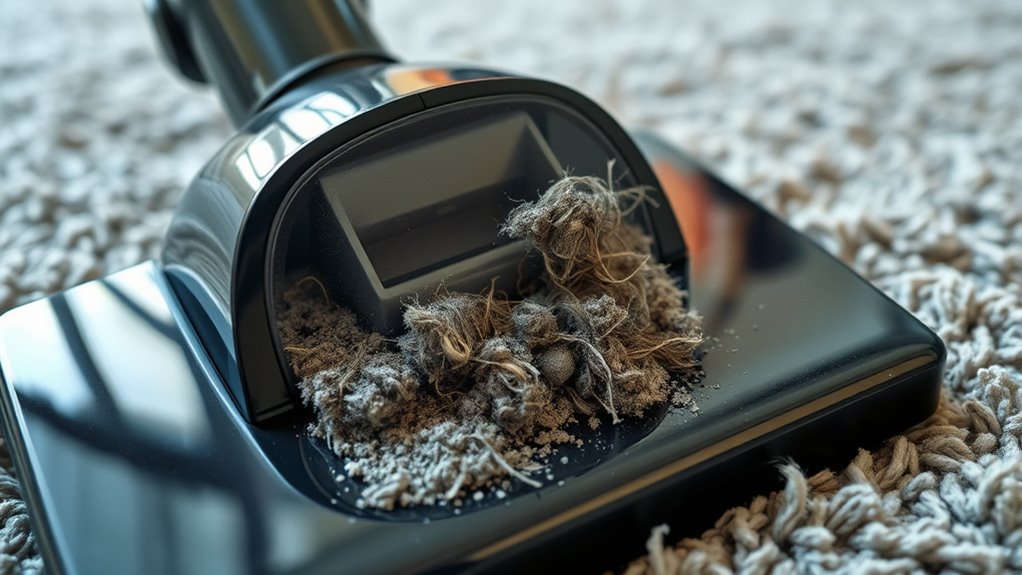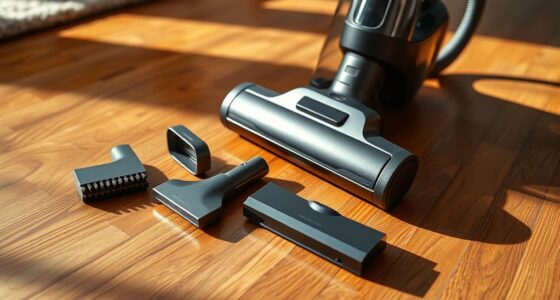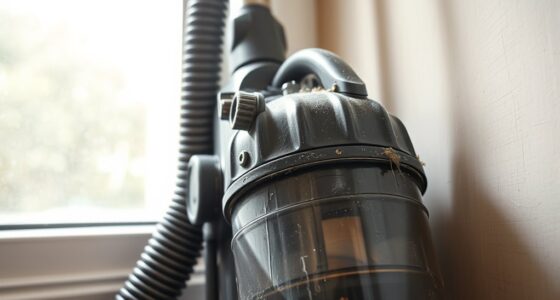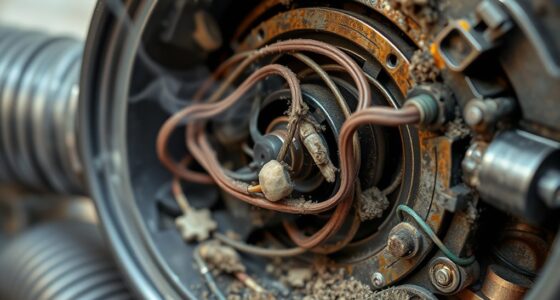Vacuums lose suction mainly because of blockages in hoses, filters, or full dust bins that restrict airflow. Worn parts like belts or brushes can also reduce power, while clogged filters force the motor to work harder. Floor type affects suction too—carpets trap more dirt, making it harder to pick up. Regular maintenance can keep your vacuum performing well, and if you want to learn how to fix issues, there’s more to discover here.
Key Takeaways
- Blockages in hoses, filters, or bags restrict airflow, diminishing suction power.
- Worn or damaged belts, brushes, or seals reduce vacuum efficiency and suction strength.
- Accumulated dirt, pet hair, or debris clogs filters and components, impeding airflow.
- Using the vacuum on incompatible floor types or neglecting maintenance lowers suction performance.
- Overfilling dust bins or unemptied bags create pressure drops, significantly reducing suction.
Understanding How Your Vacuum Creates Suction
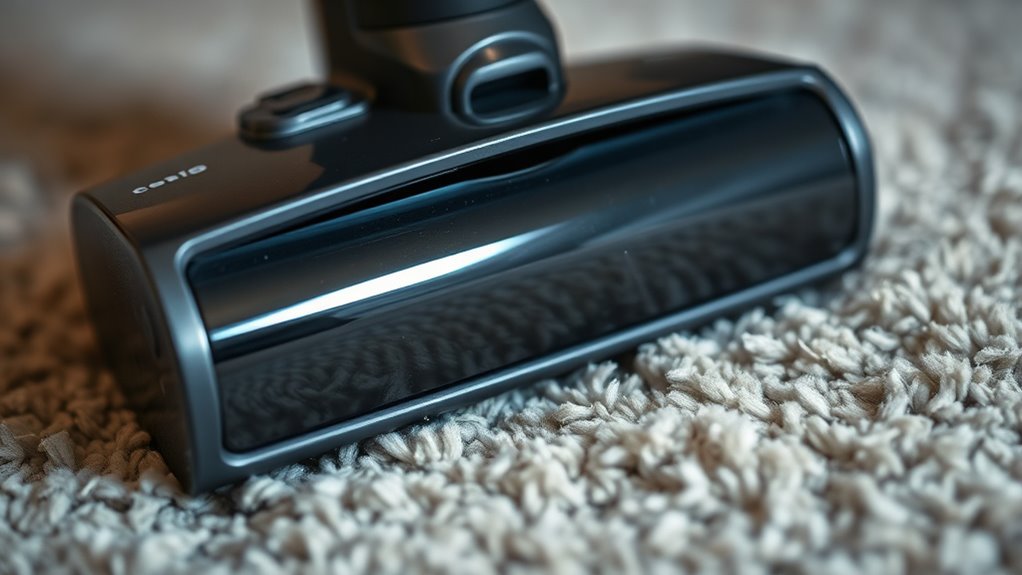
To understand how your vacuum creates suction, it’s important to know that the device uses a motor to power a fan, which rapidly spins and reduces the air pressure inside the vacuum. The vacuum motor drives this fan, generating a strong airflow that moves air out of the vacuum’s chamber. As air is expelled, a lower pressure area forms inside the vacuum, creating a suction effect. This airflow dynamics is essential for lifting dirt and debris from your floors. The faster the fan spins, the greater the airflow and the stronger the suction. By controlling the vacuum motor’s speed and airflow, your vacuum can efficiently pick up dirt, making the motor and airflow dynamics the core components behind suction power. Additionally, airflow efficiency plays a critical role in maintaining consistent suction performance over time.
Common Causes of Blockages in Vacuum Hoses and Filters
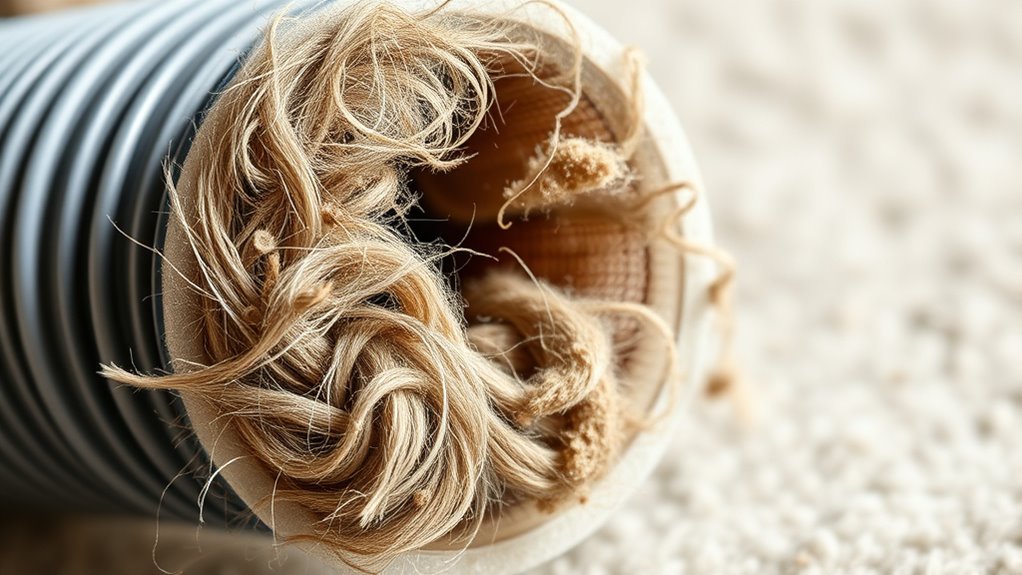
Blockages in vacuum hoses and filters are common issues that can considerably reduce your vacuum’s performance. Hose obstructions often occur when large debris, tangled hair, or small objects get lodged inside, restricting airflow. Filter blockages happen when dust, dirt, or pet hair accumulate over time, preventing proper filtration. These blockages force your vacuum to work harder, decreasing suction and cleaning efficiency. Regularly inspecting the hose for obstructions and cleaning or replacing filters can prevent these problems. Keep a close eye on areas where debris tends to build up, especially after heavy use or cleaning coarse materials. Addressing hose obstructions and filter blockages promptly ensures your vacuum maintains *ideal* suction power and prolongs its lifespan. Additionally, understanding retirement planning strategies can help you prepare financially for future needs, just as maintaining your vacuum ensures optimal performance today.
The Role of the Vacuum Bag or Dirt Bin
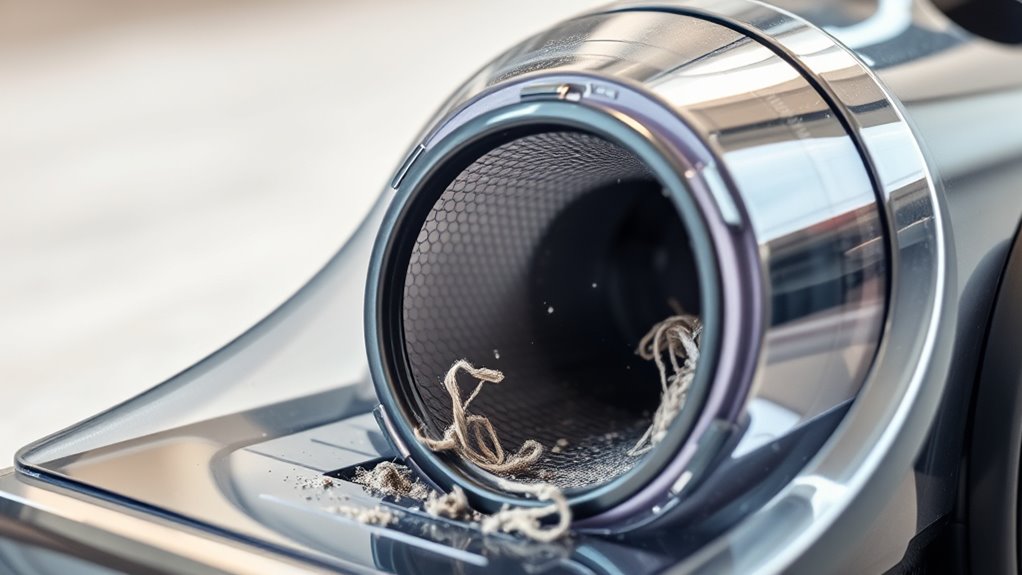
The vacuum bag or dirt bin plays a crucial role in maintaining your vacuum’s cleaning performance. When these components are full or clogged, airflow is restricted, which reduces suction power. A full vacuum bag can cause your vacuum to work harder, leading to less effective cleaning and potential motor strain. Similarly, a dirt bin that’s overflowing or not emptied regularly will hinder airflow and decrease suction. It’s essential to check and replace the vacuum bag or empty the dirt bin frequently to ensure best performance. Keeping these parts clean and properly maintained guarantees your vacuum can efficiently pick up dirt and debris without losing suction. Regularly inspecting and servicing the vacuum bag or dirt bin is a simple step to keep your vacuum functioning at its best. Additionally, using the correct paint sprayer tips and accessories can improve your painting results and reduce equipment strain.
Wear and Tear on Internal Components
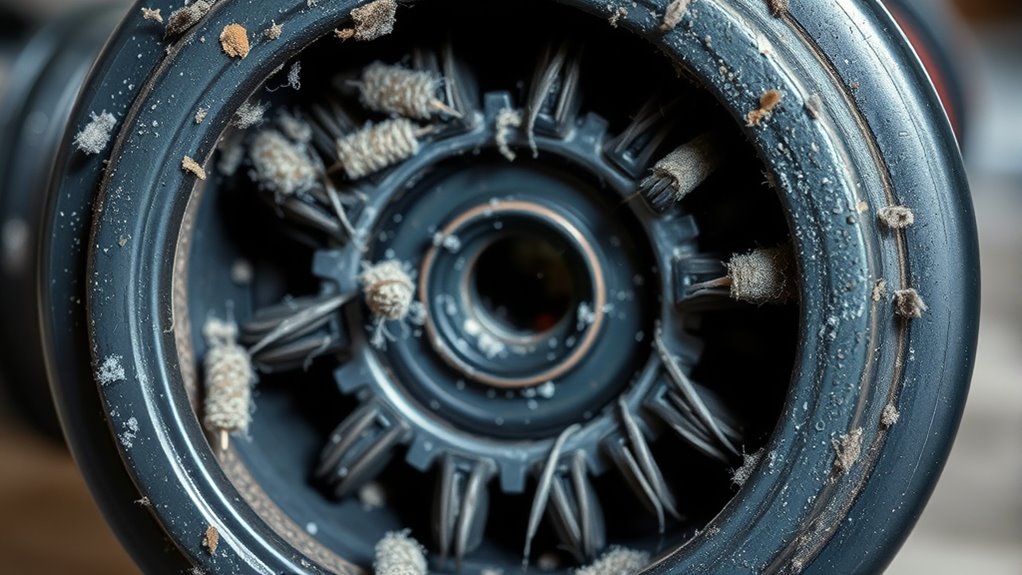
Over time, the internal components of your vacuum, such as belts, brushes, and filters, experience wear and tear from regular use. You might notice the brush wear becoming uneven or the brushes losing their effective agitation, reducing suction power. Belt damage is common when belts stretch, crack, or break, causing the brush roll to stop spinning. This not only diminishes cleaning efficiency but can also strain the motor. Regular use accelerates these issues, especially if you often vacuum debris that’s tough on components. Neglecting these signs can lead to decreased suction and more costly repairs. To keep your vacuum performing well, check belts and brushes periodically for signs of wear and replace them as needed. Staying proactive prevents further internal damage and maintains ideal suction. Additionally, understanding the wear and tear on internal components can help you identify when it’s time for maintenance or replacement to ensure optimal performance.
Proper Maintenance for Optimal Suction
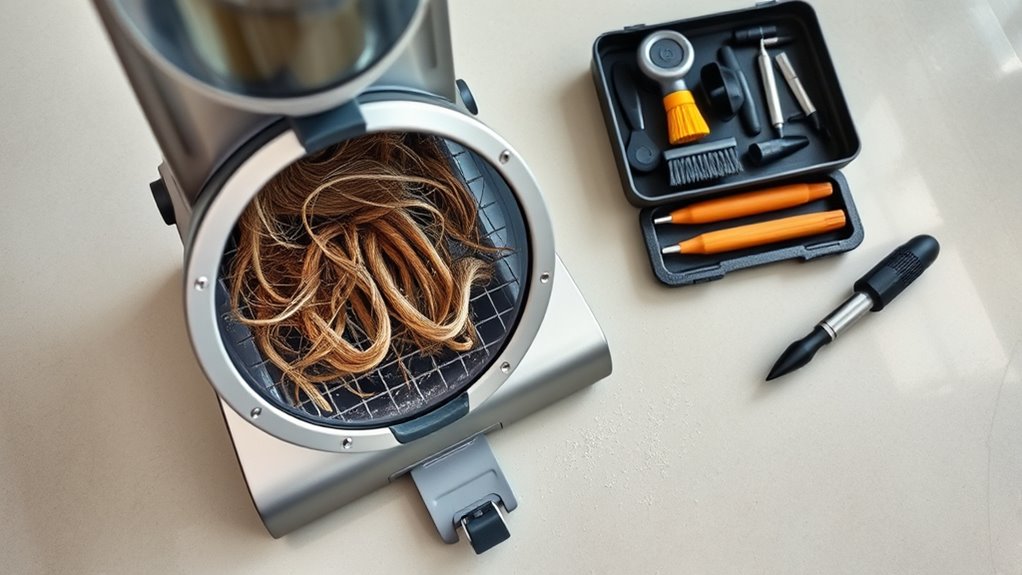
To keep your vacuum’s suction running smoothly, you need to stay on top of regular filter cleaning and check for any blockages in the hose or wand. Worn parts, like belts or brushes, should be replaced promptly to prevent loss of power. Consistent maintenance guarantees your vacuum performs at its best every time you use it. Additionally, understanding Kia Tuning options can help optimize your vehicle’s engine performance and overall handling, similar to maintaining your vacuum for peak suction.
Regular Filter Cleaning
Regular filter cleaning is essential for maintaining your vacuum’s suction power and ensuring it performs at its best. Dust buildup on the filter can considerably reduce its efficiency, causing your vacuum to struggle with debris and lose suction. By cleaning the filter regularly, you prevent clogs and maintain ideal airflow. Check your manufacturer’s guidelines for cleaning frequency, but generally, you should wash or replace the filter every few months. Use water or a gentle brush to remove dirt and dust, ensuring it’s completely dry before reinstalling. Keeping the filter clean not only restores suction but also extends the life of your vacuum. Regular maintenance like this makes sure your vacuum continues to operate efficiently and effectively, saving you time and effort during cleaning.
Check for Blockages
Even with a clean filter, blockages in your vacuum’s hoses, tubes, or brushroll can hinder airflow and reduce suction. Check the hose for kinks or clogs, paying attention to hose flexibility—over time, it can develop cracks or become stiff, trapping debris. Inspect the nozzle design for obstructions that might restrict airflow, especially around the brushroll area. Remove any debris or tangled hair that could be blocking airflow paths. Use a long, slender tool or a broomstick to clear deep blockages if necessary. Remember, a flexible hose makes it easier to identify and reach blockages, so keep it in good condition. Regularly examining these components ensures smooth airflow and helps maintain good suction performance. Additionally, understanding industry transformations can help you stay updated on the latest advancements in floor care technology that may improve your vacuum’s efficiency.
Replace Worn Parts
Worn or damaged parts can considerably reduce your vacuum’s suction power, so replacing them is essential for maintaining ideal performance. Over time, filters, brushes, and seals degrade, impacting cleaning efficiency. Regularly check these components and swap out any that show signs of wear. If your vacuum offers cordless convenience, it’s especially important to keep parts in top shape to maximize battery life and suction. Modern models with smart sensors detect blockages and component issues, alerting you when parts need replacing. By staying proactive and replacing worn parts promptly, you ensure your vacuum maintains strong suction and prolongs its lifespan. This simple maintenance step keeps your cleaning effective and prevents the frustration of performance drops over time. Additionally, understanding the importance of biodiversity in ecosystems highlights how interconnected and vital proper maintenance is for healthy environments, much like maintaining your vacuum ensures a healthy home.
How to Identify and Clear Clogs and Obstructions
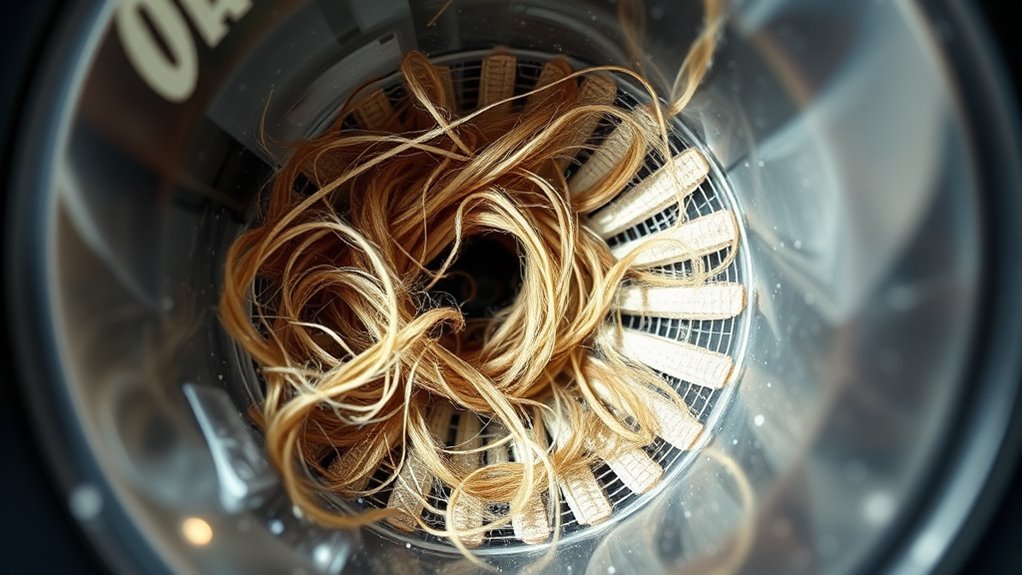
Clogs and obstructions can considerably hinder your vacuum’s performance, but identifying them is straightforward if you know what to look for. Start by checking for hose obstructions—disconnect the hose and look for blockages or debris inside. If the suction seems weak, the hose may be clogged. Next, examine the brush roll for blockages; hair, string, or debris can wrap around it, reducing airflow. Remove any tangled material and clean the brush roll thoroughly. Listen for unusual noises or decreased suction, which often indicate obstructions. Regularly inspect and clear these areas to maintain ideal suction. Additionally, understanding sound vibrations can help you recognize unusual noises that signal blockages. Clearing hose obstructions and brush roll blockages quickly helps prevent further issues and keeps your vacuum performing at its best.
The Impact of Floor Type on Suction Performance
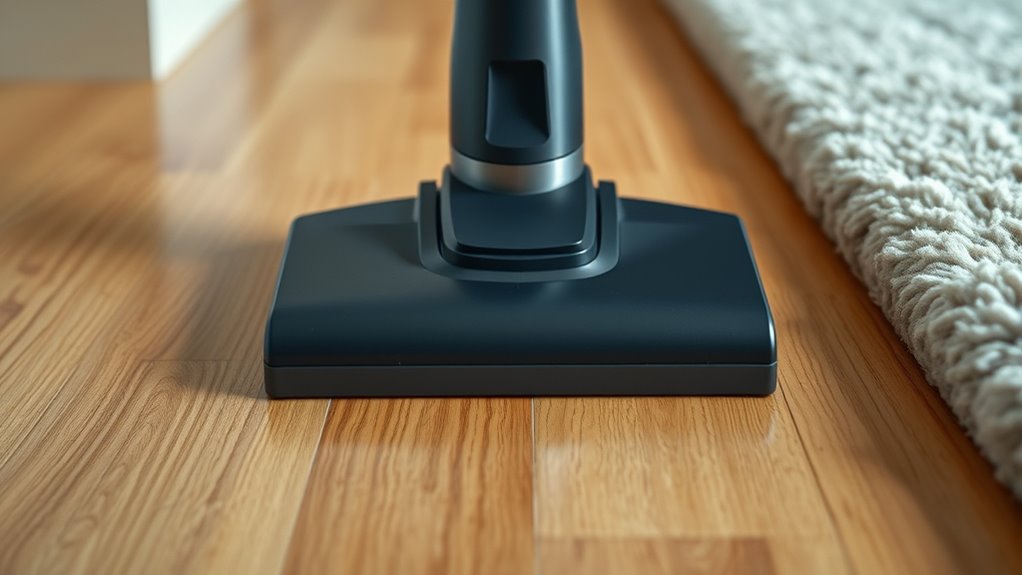
Have you noticed that your vacuum cleans differently on various floors? The floor type profoundly impacts suction performance. On carpet versus hardwood, your vacuum often struggles more with carpets because they trap dirt and debris deeper, requiring stronger suction and agitation. Hardwood floors, on the other hand, usually allow for better airflow and easier debris pickup. When comparing tile versus plush carpets, tiles tend to be easier to clean, as debris sits on the surface. Plush carpets, however, absorb more suction, which can cause your vacuum to lose power if it isn’t equipped for high-pile floors. Understanding these differences helps you choose the right settings or attachments, ensuring ideal suction and cleaning efficiency across different floor types. Additionally, using vacuum tuning techniques or choosing models designed for specific floor types can further optimize performance.
When to Replace or Repair Your Vacuum
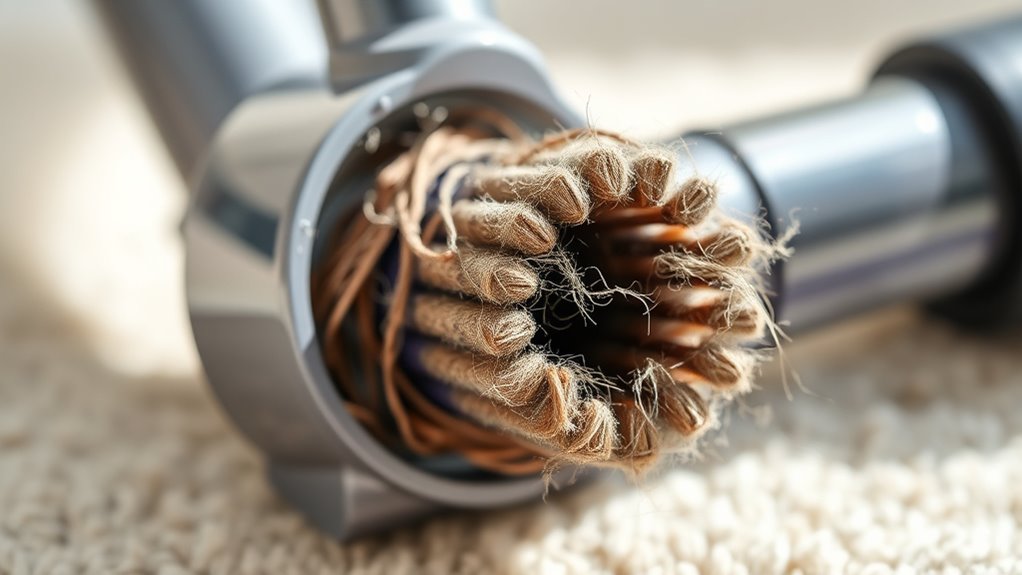
Over time, the performance of your vacuum can decline due to wear and tear from cleaning different floor types. Knowing when to replace or repair it helps you avoid frustration and wasted money. If your vacuum is out of warranty, repairs might still be worthwhile for minor issues, but persistent problems suggest replacement. Consider these factors:
- Frequent breakdowns despite repairs
- Declining suction despite cleaning filters
- Unusual noises or burning smells
- Vacuum warranties expired, and repairs cost nearly new unit
- Better options available through brand comparisons
- Monitoring your vacuum’s filter efficiency can help determine if repairs are worthwhile before opting for a replacement.
Evaluating these signs can save you money and time. Sometimes, investing in a new model with a better warranty or features is smarter than ongoing repairs. Remember, understanding your vacuum’s condition and comparing brands helps you make a well-informed decision.
Tips for Extending the Lifespan of Your Vacuum’s Suction Power
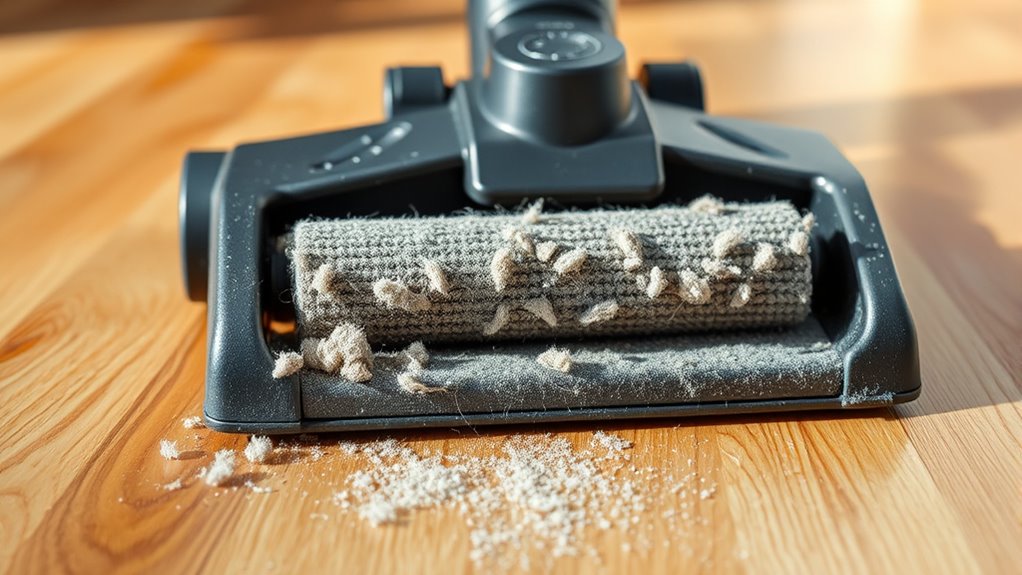
To keep your vacuum’s suction power at its best, regular maintenance is essential. Start by inspecting and cleaning vacuum accessories like brushes and filters frequently; clogged tools reduce airflow and suction. Always remove hair and debris from attachments to prevent blockages. When not in use, follow proper storage tips—store your vacuum in a dry, cool place, and keep cords neatly wound to avoid damage. Check the hose and filters regularly for dirt buildup and replace or clean them as needed. Proper storage prevents wear and tear, maintaining peak suction. Additionally, using the right vacuum accessories for different surfaces ensures efficient cleaning without straining the motor. Consistent upkeep and thoughtful storage extend your vacuum’s lifespan and keep its suction power strong.
Frequently Asked Questions
How Does Humidity Affect Vacuum Suction Performance?
Humidity effects can reduce your vacuum’s suction performance because moisture interference causes clogs and dampens airflow. When humidity levels are high, dust and debris tend to stick together or to surfaces, making it harder for your vacuum to pick up particles efficiently. You might notice decreased suction or longer cleaning times. To prevent this, keep your vacuum in a dry place and regularly check filters and hoses for moisture buildup.
Can Electrical Issues Cause a Vacuum to Lose Suction?
Electrical faults and power surges can definitely cause your vacuum to lose suction. These issues can damage internal components like the motor or circuit board, reducing airflow and cleaning power. If you notice sudden loss of suction or irregular operation, check for electrical faults or power surges. Resetting or replacing faulty parts often restores suction, but if problems persist, consider consulting a professional to avoid further damage.
Does Vacuum Age Impact Its Ability to Maintain Suction?
Your vacuum’s age definitely affects its ability to maintain suction due to age-related wear. Over time, parts like filters, belts, and hoses degrade, reducing durability and performance. As your vacuum gets older, it may struggle to pick up debris effectively. Regular maintenance helps, but eventually, the wear and tear can diminish suction power, making it necessary to replace or upgrade your vacuum for ideal cleaning results.
Are Certain Floor Types More Prone to Suction Loss?
Certain floor types, like thick carpet piles, can cause your vacuum to lose suction more quickly because they trap debris and require more power to clean effectively. Hardwood surfaces, on the other hand, tend to be easier for vacuums to handle, maintaining better suction. If you notice issues, check your vacuum’s brush roll and filters, especially if you’re cleaning high-pile carpets regularly.
How Do Cleaning Frequency and Usage Patterns Influence Vacuum Lifespan?
Your cleaning frequency and usage patterns directly impact your vacuum’s lifespan. Regular vacuum maintenance, like emptying the bin and cleaning filters, keeps suction strong. If you use your vacuum frequently or on tough debris, parts wear out faster, so user habits matter. To prolong your vacuum’s life, adopt good maintenance routines and avoid overworking it. This helps prevent premature breakdowns and keeps your vacuum performing at its best longer.
Conclusion
Keeping your vacuum’s suction strong is like tending a garden—you need to regularly clear away blockages and care for its essential parts. By understanding what causes loss of power and performing simple maintenance, you’ll guarantee it stays in peak condition. Think of your vacuum as a loyal companion—when well taken care of, it’ll always be ready to serve, transforming cleaning into a breeze rather than a battle. Stay proactive, and your vacuum will reward you with lasting performance.
